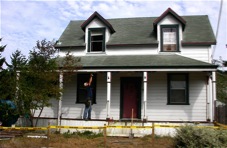Joe Ødegård, Architect — Solar heat calculations
These are the calculations for the solar space heating of the Redwood Valley Solar House. I did them by hand using an HP scientific calculator, and an architect’s scale to measure specific items on the house plans. The calculations follow Mazria’s professional edition of The Passive Solar Energy Book. The calculations are tedious but not difficult. Mazria shows how to calculate for several types of solar buildings; I used the calculation system for a “Direct Gain” building with concrete heat storage, because the Redwood Valley Solar House itself is the solar collector (like a car in the sun with the windows rolled up, except not as hot). “Concrete” heat storage means that there is enough substance in the house, in this case concrete (and all the other stuff you have in a house too), so the house warms up slowly to a comfortable temperature, and stays there until you turn in for the night. There are no moving parts, and the house never gets too hot.










Winter Sunrise

Winter Sunset



Graph V-8, from “The Passive Solar Energy Book, Professional Edition” (redrawn for web posting)
AM hours
Noon
Afternoon hours
Midnight
70º F. line, the calculated average indoor temperature for a clear day in December. (From page 3 above).


68º F. line, where you are “supposed” to set your thermostat in winter.


During the cooler hours most people are asleep anyway.
The warmest hours are early afternoon.
Evening temps drop slowly & stay above
68º till after midnight.

Graph 1, showing temperature curve above & below the average house interior temperature for a “direct gain” system with concrete as the heat storage material.
Graph 2, showing the same curve as above, with reference to a 68º F. winter thermostat setting in a conventional house.
Items D & K: The earth berm has been changed to gabbions so there is no earth contact at the wall. There will be some additional heat loss but not much compared to the total heat loss.
Items L, M, N, & O: By far the biggest heat loss comes here, from the cool outside air working its way into the house, and the warmed inside air leaving. These losses are directly related to the volume of the house. This indicates that a bloated “McMansion” is no candidate for a passive solar house.
The BTU number is certainly a nice big impressive number! But one BTU is not very much.
February has the highest heat gain because the east and west windows pick up some additional sunlight as the season advances toward spring.
The numbers on this page 3 require an input from local climate records: the average daily outdoor temperature at the building site. Counties usually have this information at their farm advisor office.
The first figure of 322 gallons of oil saved would be for a totally sunny winter, however it is easier to factor in cloudy days when you get to the end of the calculation. (Sorry to be over optimistic.) Assume that 45% of the days are cloudy. Then 322 x .55 equals 177 gallons of oil saved, or 3.2 barrels.
There are three other imponderable factors here as well:
1. Cloudy days in winter are usually warmer than sunny days in winter, so the equivalent heating fuel use on the cloudy days would be less than the solar fuel “use” for a sunny day.
2. Directly saving the equivalent of a barrel of oil at the site of the house really saves more than that because it also saves the energy otherwise used to explore for, find, extract, refine & transport the oil to the house.
3. An oil furnace is never 100 percent efficient & to replace 100 BTUs of sun takes a bit more than 100 BTUs worth of oil.
These temperature curves are from Mazria’s Passive Solar Energy Book, Professional Edition. This is an old work (1979) and one of the goals of this project is to instrument the house after it is built and gather more data.
When the sun is out in winter this house will ned no heating fuel. It uses a modest amount of renewable cordwood during cloudy weather.

Contact:


To go back to the main Redwood Valley Solar House Page, click on the little drawing above.
Home




